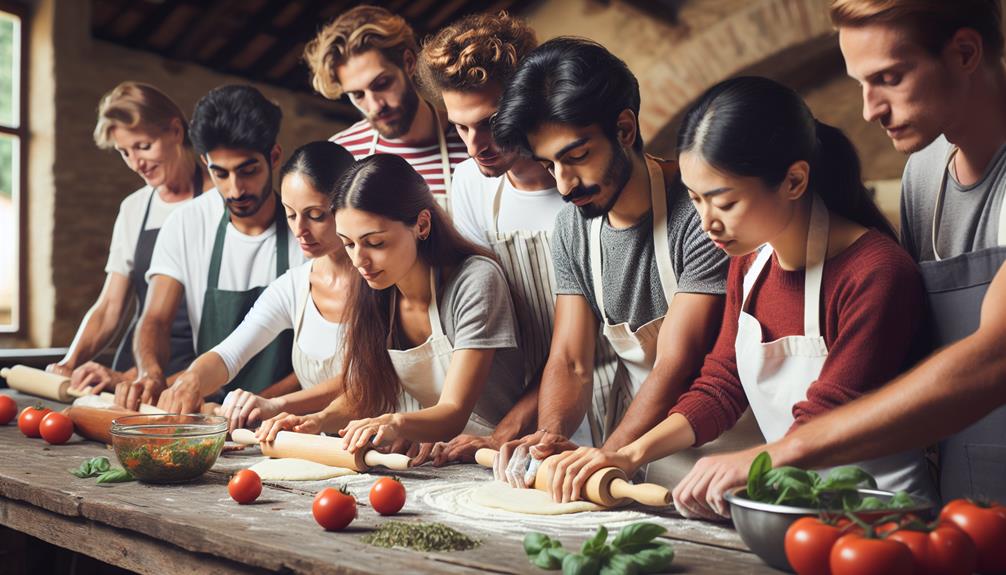Are you ready to embark on a culinary adventure through the rolling hills of Tuscany?
Imagine yourself in a charming Italian kitchen,surrounded by the aroma of freshly baked bread and simmering pots of rich tomato sauce.
In these cooking classes,you will not only learn the secrets of authentic Italian cuisine but also discover the essential techniques that make it so unique.
From mastering the art of homemade pasta to crafting traditional Tuscan dishes,each lesson will transport you to the heart of Italy’s gastronomic traditions.
So,come with an appetite and a desire to delve into the flavors of Tuscany – a world of culinary wonders awaits.

Tuscan Cooking Class Options
Discover the tantalizing array of Tuscan cooking class options that will transport you to the heart of Italy’s culinary paradise. Immerse yourself in the rich traditions of Tuscan cuisine,as you learn to create mouthwatering dishes bursting with flavors that have been perfected over centuries. From rustic farmhouses nestled amidst rolling vineyards to charming villas in picturesque hilltop towns,the options for indulging in a truly authentic culinary experience are endless.
Enroll in a hands-on cooking class led by passionate local chefs,who’ll guide you through the art of making delicious pasta from scratch. Feel the satisfying texture of the dough beneath your fingertips as you knead and shape it into delicate strands of tagliatelle or pillowy pillows of gnocchi. Inhale the fragrant aromas of fresh herbs and tomatoes as you prepare a traditional ragu sauce,simmering slowly on the stove.
Or perhaps you prefer to embark on a culinary adventure through the vibrant markets of Florence,where you can select your own ingredients and learn to transform them into delectable dishes. Get swept away by the vibrant colors and intoxicating scents of locally grown produce,as you handpick the ripest tomatoes,the freshest basil,and the juiciest lemons. Let the market guide your menu,as you create a feast inspired by the season’s bounty.
Essential Techniques for Italian Cooking
Immerse yourself in the art of Tuscan cuisine by mastering the essential techniques for Italian cooking,where each dish tells a story of tradition,passion,and exquisite flavors.
Begin your culinary journey by learning the art of pasta making. Feel the silky texture of the dough as you knead it with your hands,shaping it into delicate ribbons of tagliatelle or tiny pockets of ravioli. Watch as the pasta cooks in boiling water,releasing its tantalizing aroma,before indulging in its tender bite.
Mastering these essential techniques for Italian cooking won’t only elevate your skills in the kitchen but also allow you to create dishes that embody the heart and soul of Tuscan cuisine. So grab your apron and immerse yourself in the magic of Italian cooking,where each recipe you create tells a story of tradition,passion,and the pure joy of savoring every bite.
A Culinary Journey Through Tuscany
Embark on a sensory adventure as you traverse the picturesque landscapes and vibrant flavors of Tuscany on an unforgettable culinary journey. Allow yourself to be enveloped by the rolling hills,adorned with vineyards and olive groves,painting a breathtaking tapestry of greens and golds against the azure sky. The air is filled with the intoxicating aroma of freshly baked bread mingling with the sweet fragrance of ripened tomatoes and basil.
On this culinary journey,the flavors of Tuscany will linger on your palate,forever etching themselves into your memory. Let the warmth of the Tuscan sun and the passion of its people ignite your love for authentic Italian cuisine.
Discover More About Tuscany’s Vibrant Music Landscape
As our exploration of Tuscany’s rich musical heritage concludes,we invite you to dive deeper into the heart of Italy’s artistic soul. Whether it’s the soaring arias of an open-air opera or the rustic charm of a local folk festival,the region offers a symphony of experiences for every music lover. For those seeking to immerse themselves fully in the Tuscan lifestyle,consider extending your stay in one of the region’s beautiful accommodations. Read our detailed article on villas in Tuscany for rent to find the perfect retreat from which to enjoy the melodies of this enchanting Italian paradise.